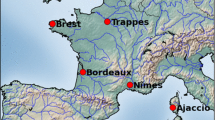Abstract
A limited-area seven-layer physical-numerical model for the lower tropospheric region (surface - 1600m) is described. The grid interval, approximately 190km, is half that of the standard numerical weather-prediction grid used in the hemispheric free atmospheric operational model at the Air Force Global Weather Central (AFGWC). This model is an integral part of the complete AFGWC meso-scale (sub-synoptic) numerical analysis and prediction system and is used to provide greater horizontal and vertical resolution in both numerical analyses and forecasts.
Important features of this boundary-layer model include: a completely automated objective analysis of input data; the transport of heat and moisture by three-dimensional wind flow; latent heat exchange in water substance phase changes; and eddy fluxes of heat and water vapor.
Input data are conventional synoptic surface and upper air reports. Other operational AFGWC prediction models provide input in the form of horizontal wind components at the upper boundary and an estimate of cloudiness above the boundary layer. Forecasts for the lower boundary and surface layer are empirically derived. Despite some approximations which broadly simplify the real planetary boundary-layer processes, operational use for highly weather-sensitive Air Weather Service support indicates that the model is capable of producing accurate detailed forecasts for periods of up to 24h.
Similar content being viewed by others
References
Barnes, S. L.: 1964, ‘Techniques for Maximizing Details in Numerical Weather Analysis’,J. Appl. Meteorol. 3, 396–409.
Blackadar, A. K.: 1963, ‘The Vertical Distribution of Wind in a Baroclinic Adiabatic Atmosphere Boundary Layer’, Dept. of Meterorology, Pennsylvania State University (unpublished).
Estoque, M. A.: 1962, ‘The Sea Breeze as a Function of the Prevailing Synoptic Situation’,J. Atmospheric Sci. 19, 425–37.
Estoque, M. A.: 1963, ‘A Numerical Model of the Atmospheric Boundary Layer’,J. Geophys. Res. 68, 1103–13.
Fleming, R. J.: 1968, ‘AFGWC Fine-Mesh Upper Air Analysis Model’,AFGWC TM 69-2, Air Force Global Weather Central, Offutt AFB, NE.
Gerrity, J. P.: 1967, ‘A Physical-Numerical Model for the Prediction of Synoptic-Scale Low Cloudiness’,Monthly Weather Rev. 95, 261–8.
Kerlin, J.: 1969, ‘AFGWC Meso-Scale Prediction Model’,AFGWC TM 70-1, Air Force Global Weather Central, Offutt AFB, NE.
McDonald, J. E.: 1963, ‘The Saturation Adjustment in Numerical Modelling of Fog’,J. Atmospheric Sci. 10, 476–8.
Pandolfo, J. P., Cooley, D. S., and Newburg, E. A.: 1963, ‘Preliminary Investigations of Numerical Models for the Short-Period Prediction of Wind, Temperature and Moisture in the Atmospheric Boundary Layer’,Final Report 7047, U. S. Weather Bureau Contract CWB-10368. The Travelers Research Center, Inc., Hartford, Conn.
Priestley, C. H. B.: 1959, ‘Turbulent Transfer in the Lower Atmosphere’,University Of Chicago Press, Chicago, Ill., 130 pp.
Tetens, O.: 1930, ‘Über einige meteorologische Begriffe’.Z. Geophys. 6, 297–309.
Author information
Authors and Affiliations
Additional information
A modified version of this paper was presented at the IUGG-IAMAP-AMS conference on Planetary Boundary Layers at Boulder, Colo., 18–21 March, 1970, and at the 5th annual Congress of the Canadian Meteorological Society, at Macdonald College, 12–14 May, 1971.
Rights and permissions
About this article
Cite this article
Hadeen, K.D., Friend, A.L. The Air Force Global Weather Central operational boundary-layer model. Boundary-Layer Meteorol 3, 98–112 (1972). https://doi.org/10.1007/BF00769110
Accepted:
Issue Date:
DOI: https://doi.org/10.1007/BF00769110




